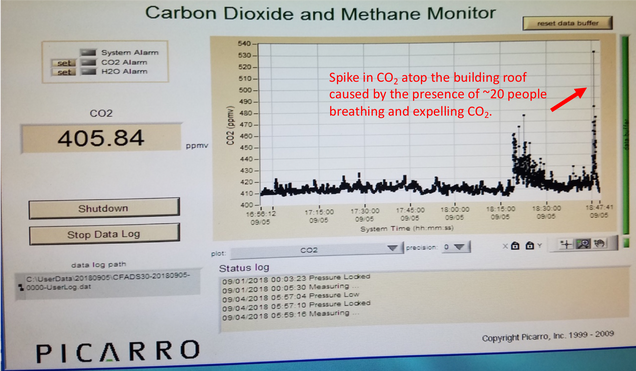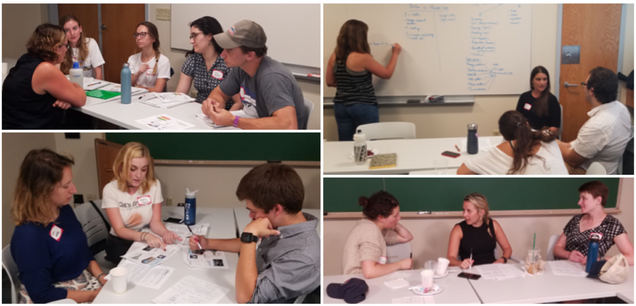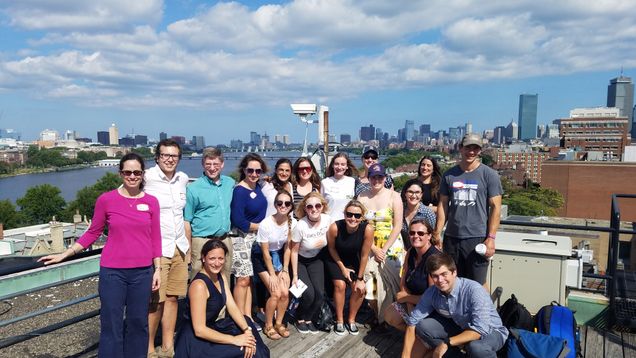The first BU URBAN Workshop is a success!
One day into the fall semester at Boston University we hosted our first BU URBAN Introductory Workshop. We were excited to meet our 14 trainees of the 2018 cohort for the first time and made sure to help them get the most out of this 4-hour event. In contrast to our last event, the weather could not have been better for our planned trip to the BU Urban Laboratory atop the roof of one of BU’s largest buildings.
We began the workshop with two rounds of “Human Bingo”. For about 15 minutes trainees, faculty, and staff walked around the room asking each other questions like “Is your age a prime number?”, “Do you dislike ice cream?”, “Do you commute to BU by bike?”, or “Are you a night owl?”. Two doctoral students from Environmental Health, Lindsey Butler and Kate Connolly, were strategic and won! They received $10 gift cards to a nearby coffeeshop – a welcome gift for busy students!
Following the introductions, we covered basics of the program and its requirements before we walked across Commonwealth Avenue to visit the BU Urban Laboratory. This research site, situated on the roof of the College of Arts and Sciences Building, has high-precision sensors that measure atmospheric mercury, carbon dioxide, water vapor, and nitrogen deposition.
Atop the roof Dr. Lucy Hutyra, Associate Director of the URBAN Program, talked about what influences urban atmospheric CO2 concentrations and how measurements can tell us stories about the key processes at play. She elaborated on what role vegetation plays in the city environment and referred to a recent study published in PNAS that revealed that uptake of CO2 by vegetation can completely offset urban CO2 emissions in summer months!
Dr. Pamela Templer, Director of the Program, followed up with an overview of the controls and processes affecting nitrogen deposition in urban environments. She explained that her instruments are part of the National Atmospheric Deposition Program, which coordinates measurements of atmospheric deposition across the U.S. The suite of instruments at the rooftop BU Urban Laboratory are novel and provide critical information that permits us to understand urban environmental challenges and solutions.
Finally, Dr. Jon Levy, Associate Director of the URBAN Program, gave a primer on indoor CO2 and how it influences public health. People are most familiar with CO2 concentrations related to climate change, often characterized by data from an isolated observatory in Mauna Loa, Hawaii, which has been tracking global CO2 concentrations over the last several decades. However, high concentrations of indoor CO2 can also be problematic.

With these introductions on the carbon and nitrogen cycle completed, trainees engaged in group discussion about the following questions:
- If you had sufficient time, what kind of data would you ideally collect to determine the contributions of local sources and sinks to outdoor CO2 or the factors influencing CO2 in classrooms? Discuss what you would measure, where, and when; what ancillary data would you collect?
- How do you expect diurnal CO2 patterns to differ between Boston (both indoors and outdoors) and Mauna Loa? Does it matter where you collect measurements in Boston?
- How would you figure out if either the ambient CO2 concentrations in Boston or the CO2 in BU classrooms was a problem? And if it is a problem, what are the candidate solutions? Who would you tell, what would you tell them, and how do you think they would respond?

Trainees walked away with knowledge about how intertwined the two disciplines of Environmental Health and Biogeoscience are in urban systems and were excited to start tackling current urban challenges as part of their hands-on training that the BU URBAN program provides!
